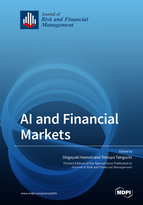AI and Financial Markets
A special issue of Journal of Risk and Financial Management (ISSN 1911-8074). This special issue belongs to the section "Financial Technology and Innovation".
Deadline for manuscript submissions: closed (31 December 2020) | Viewed by 72384
Special Issue Editors
Interests: applied time series analysis; empirical finance; data science; international financeapplied time series analysis; international finance
Special Issues, Collections and Topics in MDPI journals
Special Issue Information
Dear Colleagues,
Artificial intelligence (AI) is regarded as the science and technology for producing an intelligent machine, particularly, an intelligent computer program. Machine learning is an approach to realize AI and is a collection of statistical algorithms. Because of the rapid development of computer technology, machine learning has been actively explored for a variety of academic and practical purposes in financial markets. This Special Issue focuses on the broad topic of “AI and Financial Markets” and includes novel research associated with this topic. Articles on the application of AI to financial markets are welcome.
The Special Issue could include contributions on the application of AI to asset return forecasting, volatility forecasting, portfolio allocation, market risk, credit analysis, and so on.
Prof. Dr. Shigeyuki Hamori
Prof. Dr. Tetsuya Takiguchi
Guest Editors
Manuscript Submission Information
Manuscripts should be submitted online at www.mdpi.com by registering and logging in to this website. Once you are registered, click here to go to the submission form. Manuscripts can be submitted until the deadline. All submissions that pass pre-check are peer-reviewed. Accepted papers will be published continuously in the journal (as soon as accepted) and will be listed together on the special issue website. Research articles, review articles as well as short communications are invited. For planned papers, a title and short abstract (about 100 words) can be sent to the Editorial Office for announcement on this website.
Submitted manuscripts should not have been published previously, nor be under consideration for publication elsewhere (except conference proceedings papers). All manuscripts are thoroughly refereed through a single-blind peer-review process. A guide for authors and other relevant information for submission of manuscripts is available on the Instructions for Authors page. Journal of Risk and Financial Management is an international peer-reviewed open access monthly journal published by MDPI.
Please visit the Instructions for Authors page before submitting a manuscript. The Article Processing Charge (APC) for publication in this open access journal is 1400 CHF (Swiss Francs). Submitted papers should be well formatted and use good English. Authors may use MDPI's English editing service prior to publication or during author revisions.
Keywords
- Artificial intelligence (AI)
- Machine learning
- Supervised learning
- Unsupervised learning
- Reinforcement learning
- Regression
- Classification
- Deep learning
- Asset return forecasting
- Volatility forecasting
- Portfolio allocation
- Market risk
- High-frequency trading
Related Special Issue
- Empirical Finance Research in Journal of Risk and Financial Management (27 articles)






